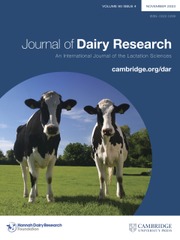No CrossRef data available.
Article contents
Evaluation of maturation changes in the handcrafted waxed dry cheese from Southern Mexico using infrared spectroscopy and chemometrics: prospective tools for adding value to local products
Published online by Cambridge University Press: 08 September 2025
Abstract
Changes in waxed dry cheese during the ripening process, over periods of 7 and 30 days, were analysed using near-infrared spectroscopy (FT-NIR) and mid-infrared spectroscopy (FT-MIR) by attenuated total reflection (ATR). FT-NIR was employed to determine the proximate composition of the cheese (protein, fat, moisture, total solids, and salt content), identifying changes directly associated with the ripening process. FT-MIR data were used to identify spectral bands associated with chemical changes occurring during the cheese maturation. Additionally, chemometric techniques were applied to demonstrate the potential of FT-MIR infrared spectroscopy for cheese differentiation and fingerprint profiling. Subsequently, partial least squares discriminant analysis (PLS-DA) of the FT-MIR spectra was performed, revealing two distinct clusters representing the cheese ripening times. Functional groups related to lipids (–CH2 – and – CH3), proteins (amide bands I and II), and carbohydrates (C–O) were identified, correlating to lipolysis, proteolysis, and lactose catabolism. Infrared spectroscopy in combination with chemometric methods proved to be a robust and reliable tool for monitoring changes during the ripening of waxed dry cheese. The results obtained highlight its usefulness as an alternative approach for the analysis and fingerprinting of traditional Mexican foods, aiming to add value to local products.
Keywords
Information
- Type
- Research Article
- Information
- Copyright
- © The Author(s), 2025. Published by Cambridge University Press on behalf of Hannah Dairy Research Foundation.

